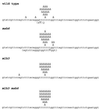The Saccharomyces cerevisiae MLH3 gene functions in MSH3-dependent suppression of frameshift mutations
- PMID: 9770499
- PMCID: PMC22844
- DOI: 10.1073/pnas.95.21.12404
The Saccharomyces cerevisiae MLH3 gene functions in MSH3-dependent suppression of frameshift mutations
Abstract
The Saccharomyces cerevisiae genome encodes four MutL homologs. Of these, MLH1 and PMS1 are known to act in the MSH2-dependent pathway that repairs DNA mismatches. We have investigated the role of MLH3 in mismatch repair. Mutations in MLH3 increased the rate of reversion of the hom3-10 allele by increasing the rate of deletion of a single T in a run of 7 Ts. Combination of mutations in MLH3 and MSH6 caused a synergistic increase in the hom3-10 reversion rate, whereas the hom3-10 reversion rate in an mlh3 msh3 double mutant was the same as in the respective single mutants. Similar results were observed when the accumulation of mutations at frameshift hot spots in the LYS2 gene was analyzed, although mutation of MLH3 did not cause the same extent of affect at every LYS2 frameshift hot spot. MLH3 interacted with MLH1 in a two-hybrid system. These data are consistent with the idea that a proportion of the repair of specific insertion/deletion mispairs by the MSH3-dependent mismatch repair pathway uses a heterodimeric MLH1-MLH3 complex in place of the MLH1-PMS1 complex.
Figures





References
-
- Kolodner R. Genes Dev. 1996;10:1433–1442. - PubMed
-
- Modrich P, Lahue R. Annu Rev Biochem. 1996;65:101–133. - PubMed
-
- Ceccotti S, Aquilina G, Macpherson P, Yamada M, Karran P, Bignami M. Curr Biol. 1996;6:1528–1531. - PubMed
-
- Fram R J, Cusick P S, Wilson J M, Marinus G M. Mol Pharmacol. 1985;28:51–55. - PubMed
-
- Karran P, Marinus M G. Nature (London) 1982;296:868–869. - PubMed
Publication types
MeSH terms
Substances
Grants and funding
LinkOut - more resources
Full Text Sources
Other Literature Sources
Molecular Biology Databases
Research Materials
Miscellaneous

